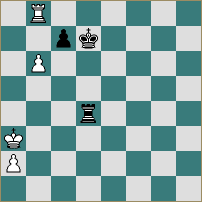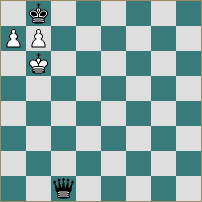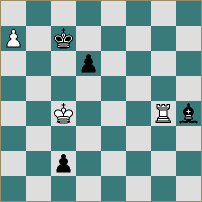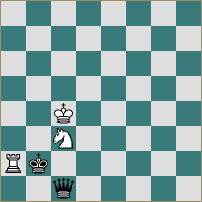Indiscrete Chess
Chess is usually regarded as a discrete (as opposed to continuous, and not to be confused with discreet) game. Assuming that there is only one way for a piece to be on a square (or that pieces are always perfectly placed in the precise center of their squares), there is a finite number of legal positions (nobody is quite sure of the precise number) and any move takes you from one such position to another. So how is it possible for chess to be considered anything other than discrete? This article attempts to illustrate a possible way, in that a certain illusion of continuity is sometimes created.
This ‘illusion of continuity’ crops up in many fields, and is crucial, for example, when watching a film. The brain can only distinguish a certain number of frames per second at the cinema and beyond that number the film appears to be continuous - the brain elides over the discontinuities. Modern films have, I believe, about 30 frames a second - which is well beyond the human eye’s ability to distinguish. Some purists with a good musical ear complain that the sound of a CD (digital) is not quite as good as that of a traditional plastic record (analogue). Psychometric measurements suggest that CDs would need to be about twice as compact as they already are (i.e. twice as much information) to satisfy these purists - with that improvement the approximation would be good enough to fool even the best human ear. They are already good enough to fool my ear.
While the digital / finite / discrete nature of chess cannot be denied in the mathematical sense, one should not forget that there is also a human factor, and it is at this point that the analogue / ‘infinite’ / continuous nature of the game creeps into the perception of the person looking at the chessboard. The notion of ‘flow’, introduced in Secrets Of Spectacular Chess (Jonathan Levitt & David Friedgood, 222 pages, Batsford 1995, £14.99 ISBN 0 7134 7721 0) as one of the four aesthetic elements, is closely related to this ‘human factor’ - indeed, it depends on it - and the examples in this article explore further ideas connected with this difficult subject.
The human factor (or the inability of the mind to process beyond a certain amount of information in a given time) varies in chess, depending on the human. The illusion of ‘flow’ occurs when there are too many ideas for a given consciousness to grasp at any one moment. In the case of the cinema, I would guess that there is no great variation in the number of frames per second distinguishable by different adults. In the case of chess, there is a big variation in different players’ capacity to process the ‘information’. This is because chess thinking involves ‘chunks’ and stronger, more experienced players have greater knowledge, allowing them to put more ‘information’ into each chunk (‘Here’s one I prepared earlier...’). Short term memory can deal with (manipulate) maybe six or seven chunks simultaneously, explaining why different players can have different grasps on the same position.
Certain positions require more thinking than others. For a piece of chess action to achieve ‘flow’ in the mind of the observer, there must be more content than can be grasped (at one moment) in the short-term memory of that observer. The ‘flow’ effect only occurs if the position allows it. The ideas stimulated by the position must rush through consciousness (filling and refilling short-term memory) at a sufficient speed to create the effect.
The first of the two examples (a study by J. Moravec) has sufficient content for most players to experience ‘flow’ as they follow the cut and thrust of the solution, although really strong solvers may just be able to see the whole solution in one fell swoop. The second example (a study by Z. Birnov from 1947 building on an earlier finish by the great Kasparyan) simply contains too much content for anybody to grasp it ‘in one’. The study can be grasped, but only as a series of stages (each of which can be understood in one ‘session’ of consciousness). In a way, each of these stages forms a further ‘chunk’ as the mind goes on to ‘understand’ the study - but here the chunks are really metachunks, quite different from the ‘chunks’ of technical chess moves mentioned earlier. I will attempt to give notes to the studies in chunk form, as I see it, although I am being somewhat simplistic about the complicated thinking process involved.
 White to play and Win
First you must know that an extra rook pawn is not enough, so if White exchanges on c7 it is just a draw. This is so obvious that it hardly constitutes a single chunk and can be dismissed without taking up any further space in the thinking process. Then you must see that the natural 1.b7? Kc6 is also drawn since moving the white rook anywhere other than d8 allows Black to capture the b7-pawn - chunk number one.
Chunk number two consists of seeing that White can give away the rook so as to try to promote the pawn.
1.Rd8+!
White to play and Win
First you must know that an extra rook pawn is not enough, so if White exchanges on c7 it is just a draw. This is so obvious that it hardly constitutes a single chunk and can be dismissed without taking up any further space in the thinking process. Then you must see that the natural 1.b7? Kc6 is also drawn since moving the white rook anywhere other than d8 allows Black to capture the b7-pawn - chunk number one.
Chunk number two consists of seeing that White can give away the rook so as to try to promote the pawn.
1.Rd8+!
1... Kxd8
2.b7 Rb4!
Seeing that this, in conjunction with Black’s next move, is the only way to stop the pawn is chunk number three. The white king is decoyed to b4 so that ...c5 comes with check, allowing the black king time to move across.
3.Kxb4 c5+
4.Kb5
Chunks number four and five are seeing that you don’t need to take the pawn (and that taking it only draws) and that the text move (or 4 Ka5) threatens to win by supporting the pawn on b7.
4... Kc7
5.Ka6 Kb8
Forced, to stop white playing 6.Ka7. If you’ve seen this sort of thing before, the remaining ‘race’ all forms a single chunk (number six):
6.Kb6 c4
7.a4 c3
8.a5 c2
9.a6 c1Q
10.a7
Checkmate, and just in time! The final position deserves a diagram:
 The queen can only look on as her partner is ‘run out’ at the other end. There is no need for the services of a third umpire.
2)
The queen can only look on as her partner is ‘run out’ at the other end. There is no need for the services of a third umpire.
2) White to play and Win
One has to start by becoming aware of the material balance and of the two pawns about to promote. Allowing Black to promote with check is clearly no good and so a process of elimination (1.Rg1? Kb7) leads to the first move. All of this is at least one chunk.
1.Rg7+
Another process of elimination leads to finding Black’s reply (chunk two).
1... Kb6!
Promoting with check suggests itself, but one has to see that there is nothing else (chunk three).
2.a8N+! Ka6
f 2...Ka5? 3.Ra7# or if 2...Kc6? 3.Rc7#. In a tactical position great precision is needed - you have to be quite sure that each of these is mate before moving on with the logic (two more chunks).
3.Nc7+ Ka5
Deducing that this is forced uses up the remaining chunks of the first stage: 3...Kb7 4.Ne6+ Kb6 5.Rg1 (and the knight controls g5) or 3...Kb6 4.Nd5+ Ka6 5.Nb4+ both leave White a rook up. About here I would have to stop my analysis, check everything was clear so far and focus again on the position after three moves.
4.Rg1 Bg5!
Stage two, first two chunks consist of seeing that 4...d5+ 5.Kb3 is lost for Black and that this resource is available (in conjunction with Black’s next move, the rook is decoyed to a square from which it cannot deal with the c-pawn). It’s an unusual trick, which makes it all the harder to see.
5.Rxg5+ d5+
White to play and Win
One has to start by becoming aware of the material balance and of the two pawns about to promote. Allowing Black to promote with check is clearly no good and so a process of elimination (1.Rg1? Kb7) leads to the first move. All of this is at least one chunk.
1.Rg7+
Another process of elimination leads to finding Black’s reply (chunk two).
1... Kb6!
Promoting with check suggests itself, but one has to see that there is nothing else (chunk three).
2.a8N+! Ka6
f 2...Ka5? 3.Ra7# or if 2...Kc6? 3.Rc7#. In a tactical position great precision is needed - you have to be quite sure that each of these is mate before moving on with the logic (two more chunks).
3.Nc7+ Ka5
Deducing that this is forced uses up the remaining chunks of the first stage: 3...Kb7 4.Ne6+ Kb6 5.Rg1 (and the knight controls g5) or 3...Kb6 4.Nd5+ Ka6 5.Nb4+ both leave White a rook up. About here I would have to stop my analysis, check everything was clear so far and focus again on the position after three moves.
4.Rg1 Bg5!
Stage two, first two chunks consist of seeing that 4...d5+ 5.Kb3 is lost for Black and that this resource is available (in conjunction with Black’s next move, the rook is decoyed to a square from which it cannot deal with the c-pawn). It’s an unusual trick, which makes it all the harder to see.
5.Rxg5+ d5+
6.Rxd5+
Now if 6...Kb6 7.Rb5+ Kxc7 8.Rc5+ Kd6 9.Kb4 covers the pawn. Another couple of chunks checking this line.
6... Ka4
It would be quite normal to stop here, concluding that Black has a draw since the pawn cannot be stopped from promoting (and with check). One might then retreat, checking all the earlier lines only to find that the original position is a draw. This whole process would use up a couple of stages. If it were a game you would not know that White has a win, but since it is a ‘White to play and win’ study, you do know and eventually, having been forced back to this position, you should find White’s next. Having experienced such ideas before in studies, I would find it with a little less pain. Still, such an exciting move would make me stop, focus again on the position after White’s seventh (with the thought ‘I could try this...’), and move on to the third stage.
7.Nb5!! c1Q+
The remaining moves would come in one chunk:
8.Nc3+ Ka3
9.Ra5+ Kb2
10.Ra2
Again, the final checkmate deserves its own diagram:
 This time the queen is not a passive spectator. It contributes to Black’s downfall by blocking the crucial flight square. Although both studies end in mate after White’s tenth move, the Kasparyan is a lot harder to solve. Many more chunks (or units) of thought are needed in order to grasp the solution. The first study is just about solvable (by a strong player) in one conscious effort; the second needs several stages, where you stop, regather your thoughts and push forward again. Both studies create the illusion of flow as the discrete moves join together to form what feels like an almost continuous whole. If you are prepared to make the intellectual effort, you should find the second study the more satisfying due to its considerably greater flow.
This time the queen is not a passive spectator. It contributes to Black’s downfall by blocking the crucial flight square. Although both studies end in mate after White’s tenth move, the Kasparyan is a lot harder to solve. Many more chunks (or units) of thought are needed in order to grasp the solution. The first study is just about solvable (by a strong player) in one conscious effort; the second needs several stages, where you stop, regather your thoughts and push forward again. Both studies create the illusion of flow as the discrete moves join together to form what feels like an almost continuous whole. If you are prepared to make the intellectual effort, you should find the second study the more satisfying due to its considerably greater flow.
Back
Top of this page
Main page
White to play and Win

White to play and Win
